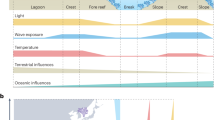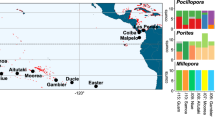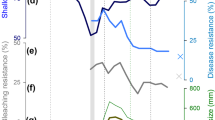Abstract
Only 17% of 111 reef-building coral genera and none of the 18 coral families with reef-builders are considered endemic to the Atlantic, whereas the corresponding percentages for the Indo-west Pacific are 76% and 39%1,2. These figures depend on the assumption that genera and families spanning the two provinces belong to the same lineages (that is, they are monophyletic). Here we show that this assumption is incorrect on the basis of analyses of mitochondrial and nuclear genes. Pervasive morphological convergence at the family level has obscured the evolutionary distinctiveness of Atlantic corals. Some Atlantic genera conventionally assigned to different families are more closely related to each other than they are to their respective Pacific ‘congeners’. Nine of the 27 genera of reef-building Atlantic corals belong to this previously unrecognized lineage, which probably diverged over 34 million years ago. Although Pacific reefs have larger numbers of more narrowly distributed species, and therefore rank higher in biodiversity hotspot analyses3, the deep evolutionary distinctiveness of many Atlantic corals should also be considered when setting conservation priorities.
This is a preview of subscription content, access via your institution
Access options
Subscribe to this journal
Receive 51 print issues and online access
$199.00 per year
only $3.90 per issue
Buy this article
- Purchase on Springer Link
- Instant access to full article PDF
Prices may be subject to local taxes which are calculated during checkout


Similar content being viewed by others
References
Veron, J. E. N. Corals in Space and Time (UNSW Press, Sydney, 1995)
Veron, J. E. N. Corals of the World (Australian Institute of Marine Science, Townsville, 2000)
Roberts, C. M. et al. Marine biodiversity hotspots and conservation priorities for tropical reefs. Science 295, 1280–1284 (2002)
Budd, A. F. Diversity and extinction in the Cenozoic history of Caribbean reefs. Coral Reefs 19, 25–35 (2000)
Romano, S. L. & Cairns, S. D. Molecular phylogenetic hypotheses for the evolution of scleractinian corals. Bull. Mar. Sci. 67, 1043–1068 (2000)
Veron, J. E. N., Odorico, D. M., Chen, C. A. & Miller, D. J. Reassessing evolutionary relationships of scleractinian corals. Coral Reefs 15, 1–9 (1996)
Chen, C. A., Wallace, C. C. & Wolstenholme, J. Analysis of the mitochondrial 12S rRNA gene supports a two-clade hypothesis of the evolutionary history of scleractinian corals. Mol. Phyl. Evol 23, 137–149 (2002)
Cuif, J.-P., Lecointre, G., Perrin, C., Tillier, A. & Tillier, S. Patterns of septal biomineralization in Scleractinia compared with their 28S rRNA phylogeny: a dual approach for a new taxonomic framework. Zool. Scripta 32, 459–473 (2003)
Vaughan, T. W. & Wells, J. W. Revision of the suborders, families, and genera of the Scleractinia. Geol. Soc. Am. Spec. Pap. 44, 1–363 (1943)
Stolarski, J. & Roniewicz, E. Towards a new synthesis of evolutionary relationships and classification of Scleractinia. J. Paleontol. 75, 1090–1108 (2001)
Wells, J. W. The recent solitary mussid scleractinian corals. Zool. Meded. 39, 375–384 (1964)
Paulay, G. in Life and Death of Coral Reefs (ed. Birkeland, C.) 298–353 (Chapman & Hall, New York, 1997)
Wallace, C. C. Journey to the heart of the centre—origins of high marine faunal diversity in the central Indo-Pacific from the perspective of an acropologist. Proc. 9th Int. Coral Reef Symp. 1, 33–39 (2002)
Shearer, T. L., van Oppen, M. J. H., Romano, S. L. & Wörheide, G. Slow mitochondrial DNA sequence evolution in the Anthozoa (Cnidaria). Mol. Ecol. 11, 2475–2487 (2002)
Mace, G. M., Gittleman, J. L. & Purvis, A. Preserving the tree of life. Science 300, 1707–1709 (2003)
Pandolfi, J. M. et al. Global trajectories of the long-term decline of coral reef ecosystems. Science 301, 955–958 (2003)
Gardner, T. A., Côté, I. M., Gill, J. A., Grant, A. & Watkinson, A. R. Long-term region-wide declines in Caribbean corals. Science 301, 958–960 (2003)
Williams, S. T., Knowlton, N., Weight, L. A. & Jara, J. A. Evidence for three major clades within the snapping shrimp genus Alpheus inferred from nuclear and mitochondrial gene sequence data. Mol. Phyl. Evol. 20, 375–389 (2001)
Lopez, J. V. & Knowlton, N. Discrimination of sibling species in the Montastraea annularis complex using multiple genetic loci. Proc. 8th Int. Coral Reef Symp. 2, 1613–1618 (1997)
Swofford, D. L. PAUP*: Phylogenetic Analysis Using Parsimony (*and other methods), Version 4.0b10 (Sinauer, Sunderland, MA, 2002)
Kimura, M. A simple method for estimating evolutionary rate of base substitutions through comparative studies of nucleotide sequences. J. Mol. Evol. 16, 111–120 (1980)
Posada, D. & Crandall, K. A. Modeltest: Testing the model of DNA substitution. Bioinformatics 14, 817–818 (1998)
Kimura, M. Estimation of evolutionary distances between homologous nucleotide sequences. Proc. Natl Acad. Sci. USA 78, 454–458 (1981)
Tamura, K. & Nei, M. Estimation of the number of nucleotide substitutions in the control region of mitochondrial DNA in humans and chimpanzees. Mol. Biol. Evol. 10, 512–526 (1993)
Acknowledgements
We thank J. Jara, E. Gomez, M. Hatta and staff of the Palau International Coral Reef Center for their assistance in the field and laboratory, and J. Jackson and R. Grosberg for comments on the manuscript. Financial support came from the National Science Foundation, the Smithsonian Institution, the Scripps Institution of Oceanography, and the Conselho Nacional de Pesquisas (CNPq). Authors' contributions. H.F. performed the collections and genetic analyses, A.F.B. the morphological and palaeontological interpretations, C.A.C. the coral molecular systematics and collections in Taiwan, G.P. the coral systematics and collections in Palau, A.S.-C. the molecular systematics and collections in Brazil, K.I. the collections in Okinawa, and N.K. the coral systematics, financial/logistic support and manuscript preparation.
Author information
Authors and Affiliations
Corresponding author
Ethics declarations
Competing interests
The authors declare that they have no competing financial interests.
Supplementary information
Supplementary Information 1
List of the species analyzed in this study and location of coral skeletons (in laboratories of respective authors). For photos of these corals, send requests to corresponding author. (DOC 32 kb)
Supplementary Information 2
50% majority-rule consensus tree of the first 10000 equally maximum-parsimonious trees inferred from MP analysis using 305 bp of the 5’-end of the nuclear 28S rRNA gene (primers from Romano and Cairns5). DNA sequences are available in DDBJ (Accession Nos. AB126702-AB126751). (PDF 1648 kb)
Rights and permissions
About this article
Cite this article
Fukami, H., Budd, A., Paulay, G. et al. Conventional taxonomy obscures deep divergence between Pacific and Atlantic corals. Nature 427, 832–835 (2004). https://doi.org/10.1038/nature02339
Received:
Accepted:
Issue Date:
DOI: https://doi.org/10.1038/nature02339
This article is cited by
-
Taxonomic resolution of coral image classification with Convolutional Neural Network
Aquatic Ecology (2023)
-
Linking coral fluorescence phenotypes to thermal bleaching in the reef-building Galaxea fascicularis from the northern South China Sea
Marine Life Science & Technology (2023)
-
Application of phylogenomic tools to unravel anthozoan evolution
Coral Reefs (2022)
-
Phylogenomics of Palythoa (Hexacorallia: Zoantharia): probing species boundaries in a globally distributed genus
Coral Reefs (2022)
-
Diversification and distribution of gall crabs (Brachyura: Cryptochiridae: Opecarcinus) associated with Agariciidae corals
Coral Reefs (2022)
Comments
By submitting a comment you agree to abide by our Terms and Community Guidelines. If you find something abusive or that does not comply with our terms or guidelines please flag it as inappropriate.



